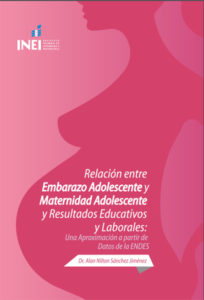Relación entre embarazo adolescente y maternidad adolescente y resultados educativos y laborales: una aproximación a partir de datos de la ENDES
| Year | : | 2019 |
|---|---|---|
| Author/s | : | Alan Sanchez |
| Area/s | : | Health and nutrition |
Sanchez, Alan (2019). Relación entre embarazo adolescente y maternidad adolescente y resultados educativos y laborales: una aproximación a partir de datos de la ENDES. Lima: INEI.
The international literature shows that teenage pregnancy is associated to negative results for the mother in terms of educational achievement and access to the labour market. However, there is limited evidence about this for the Peruvian case. Within this context, this study has three objectives. First, document the prevalence of teenage pregnancy in Peru between 2012 and 2017. Second, measure the association between being a teenage mother, educational outcomes, and access to the labour market in the short term (between ages 15 and 19) and in the medium term (between ages 20 and 24). Third, establish to what extent the associations found are heterogeneous according to natural region, area of residence, and also according to certain characteristics of the pregnancy, and the moment in which results are measured. Data from the Encuesta Demográfica y de Salud Familiar is used for this analysis.
Main results are as follows: (i) according to the methodology proposes in this study, the prevalence of teenage mothers in Peru is 14,3% (in 2017). The highest rates are observed in the Amazonian Jungle and in rural areas; (ii) being a teenage mother is associated to a lower probability of attending formal education, a higher probability of repeating school grades and dropping-out in the short term, and a lower probability of completing basic education and attending higher education in the medium term; (iii) the association between being a teenage mother, labour market participation and having a job is positive in the short term and negative in the medium term; (iv) there is heterogeneity in the results observed by area of residence, natural region, and also according to whether or not pregnancy was desired by the mother, whether or not the mother lives with the father of the child, and according to the exact time elapsed since the moment of birth.







